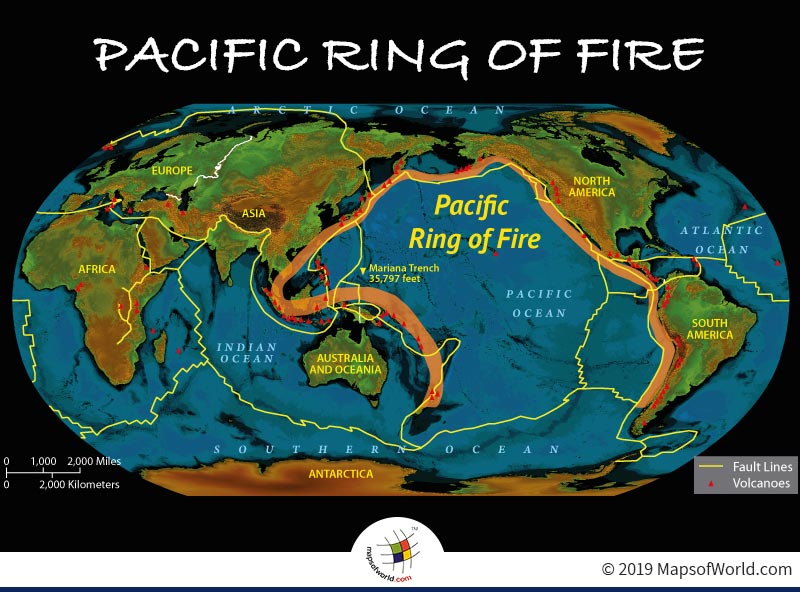

Map Depicting The Pacific Ring of Fire
The Pacific Ring of Fire is one of the most turbulent regions of the earth. Covering a length of 24,900 square miles, the Pacific Ring of Fire comprises roughly 75 percent of the volcanoes that erupt frequently across the globe. The Pacific Ring of Fire is also prone to seismic activity and an estimated 90 percent of the world’s earthquakes occur along this region. Contrary to its name, the Pacific Ring of Fire resembles more of a horseshoe. The huge area stretches from South America’s southern tip to New Zealand and passes through North America, Bering Strait, and Japan. The Pacific Ring of Fire ends in Antarctica.
The Ring of Fire is such a volatile region because of plate tectonics. These plates are basically huge slabs of the Earth’s crust, that are not steady but are usually joined together like pieces that comprise puzzles and keep on moving on top of the mantle, which is molten and solid rock. These plates witness constant activity and at times either collide with each other, move away or even slide next to each other. It is these geological active zones in the Ring of Fire that witness most of the tectonic activity.
People living along fault lines are always at risk as they are exposed to earthquakes, volcanoes, and tsunamis. Some of the countries or regions that are at a risk include the west coast of the United States, Solomon Islands, Japan, Chile, Papua New Guinea, Philippines, Russia, Mexico, Canada, Peru, Guatemala, Indonesia, Taiwan, New Zealand, and the continent of Antarctica.
The region has been home to some of the deadliest earthquakes and tsunamis. One of the most destructive tsunamis that caused massive loss of life and property was the Indian Ocean earthquake and tsunami that took place in 2004. More than 200,000 people were killed and the areas that were largely affected included Thailand, Malaysia, Indonesia, Myanmar, India, Sri Lanka, Bangladesh, Yemen, South Africa, Somalia, Maldives, Madagascar, Kenya, Tanzania, and Seychelles. Some other devastating earthquakes that took place in the region included the Chile earthquake (1960), the Alaska earthquake (1964), the Chile earthquake (2010), and the Japan earthquake (2011). Meanwhile, the volcanic eruptions to have taken place here are Mount Tambora (1815), Krakatoa (1883), Novarupta (1912), Mount Saint Helens (1980), Mount Ruiz (1985), and Mount Pinatubo (1991).
Related Links:
Related Maps:
The Republic of Madagascar is an island country located in the Indian Ocean, off the…
The Euro is the official currency of the European Union. It is, however, not incumbent…
There are many countries or regions that are partially recognized by the UN, have disputes…
The Alaska Statehood Act was signed into law by President Dwight D. Eisenhower in 1958,…
The name Persia may, however, only be used to refer to Iran in some contexts.…
Hawaii is an Island State in the US. It is one of the 50 states…